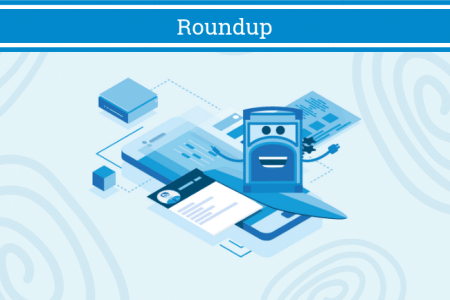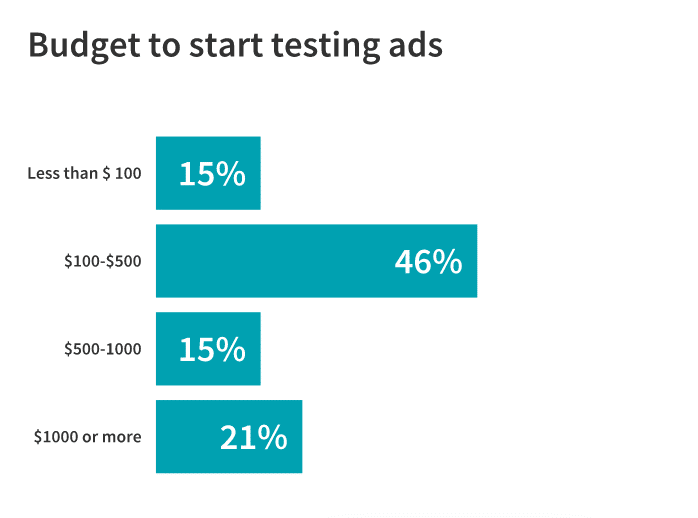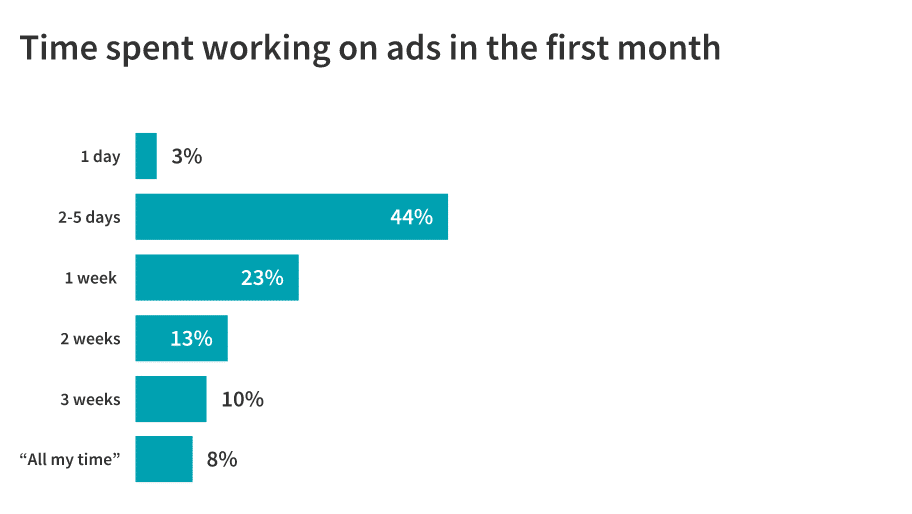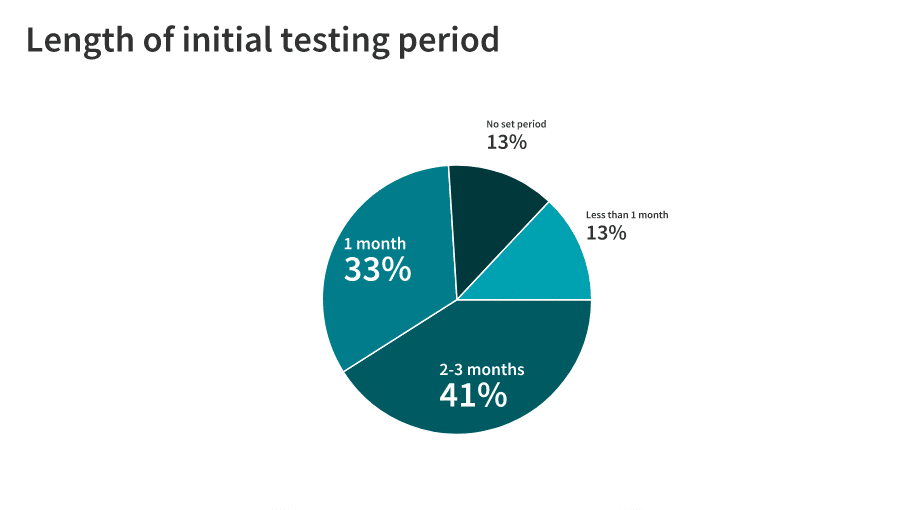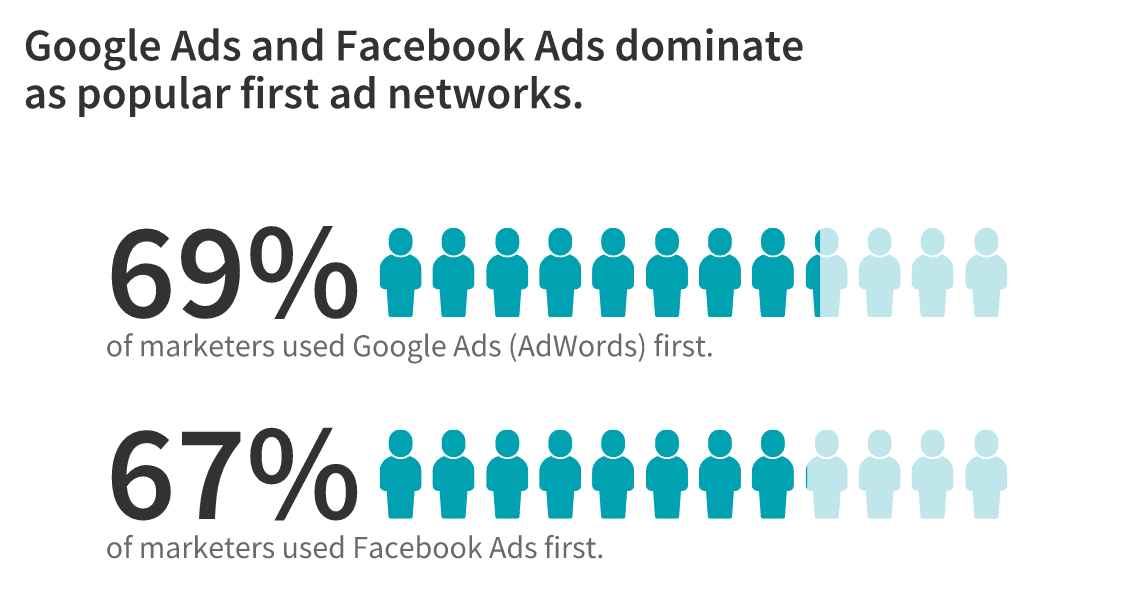To start attracting new leads and remarket to past customers, it’s wise to learn about getting started with paid ads. This is precisely why we wanted to reach out to see how other marketers got started using paid media so that we could learn tips and tricks for getting started in this realm.
We ran a survey to learn marketers’ best tips for getting started with paid ads, and 39 respondents shared their insights. The survey consisted of four multiple-choice questions and two open-ended response prompts. We’ll cover the tips themselves later in the article, but first, let’s take a look at the surprising statistics that we found.
Most marketers only spend a week or less testing new ads
First, we asked marketers about their initial budget when they started testing ads. We offered four numerical responses ranging from less than $100 to $1000 or more.
- 46% said they allotted between $100 and $500 for their ad budget
- 21% spent $1000 or more
- 15% spent between $500 and $1000
- 15% spent less than $100.
- 3% did not have an answer to the question or answered with something other than numerical data.
We also asked marketers to share their investments of time within their first month of working on ads, by selecting one of 6 set responses ranging from 1 day to the entire month (“all their time”).
The majority of marketers (70%) reported that they spent one week or less working on ads.
In the survey, 3% of respondents spent only one day on ads, and 8% of respondents spent all their time on ads, showing great variety in time investments in between.
Most respondents set a longer initial testing period
The majority of our respondents (87%) defined a set testing period to gauge their ads’ efficacy.
About 41% of the marketers used a two to three month testing period (the most popular response), and 33% tested their ads for one month. Longer testing periods of at least a month were preferred, and only 13% did not have any set period for testing.
There are two clear winners when it comes to ad networks
We also wanted to see which ad networks marketers turned to when they first started to work with paid ads. Marketers were allowed to select multiple responses to this question and were also allowed to add their own response if a network they used was not listed.
Although marketers shared a wide variety of responses, two networks dominated as popular choices: Google Ads (69%) and Facebook Ads (67%).
In comparison, only 26% used the third most popular platform, Bing Ads. All the other platforms listed were each used by 5% or less of the respondents.
Interestingly, just over half of the marketers we surveyed (54%) used two or more ad networks when they first started out. Meanwhile, 46% chose to use a single ad network. Testing out multiple options was the more popular choice, but not by much.

What surprised marketers about paid ads
Working with paid ads can bring unexpected insights, challenges, and successes. We wanted to share what surprised our surveyed marketers most when they first started with paid ads, so you’re more aware of what to expect when you begin this process.
1. Ads drive rapid, real-time results
When properly set up, ads can be an effective way to quickly drive traffic and convert new customers. Several of the marketers we surveyed were shocked by just how powerful paid ads can be.
Karri Gonzalez of EZMarketing encourages other marketers not to underestimate ads’ efficacy, regardless of their own point of view as a consumer: “I was surprised by how effective ads could be – I’ve personally rarely clicked on an ad and have certainly never converted on one personally, so in the back of my mind I doubted their effectiveness because I was judging them based on my own consumer behavior.”
Morgan Taylor of Jolly Content “was surprised how quickly a pay per click campaign was able to drive traffic to the company’s site,” and reports that “it was only a matter of days before the results started showing.”
Like several other marketers, Jamie Burgess from Cariad Marketing was surprised by “how responsive paid traffic is” compared to the organic traffic gained from search results. “Coming from an SEO background, I was used to waiting weeks and months for trickles of visitors to start coming,” Burgess explains. “Being able to drive targeted traffic immediately after setting up the campaigns, and having actionable data about what was working and what wasn’t fairly quickly was a game changer for me personally.”
Similarly, this rapidity of results pleasantly surprised Jean-Philippe Fortin-Cantin from DashThis: “At first, I was really surprised by the results being almost real-time…Compared to other marketing efforts such as social media or SEO, with Google Ads you quickly see the results of your work and can adjust accordingly.”
Lewis Peters of Online Turf also experienced improved results compared with organic traffic: “By using a combination of text ads & shopping ads and experimenting with the different search & display networks, we very quickly managed to get more sales via paid traffic than organic.”
2. Developing ads can take more time than many people expect
Paid ads can require large time investments before they deliver worthwhile results. “The lengthy process which was involved in creating my test advert surprised me,” says Ollie Smith of EnergySeek. “I went on a journey from initial brainstorming, SWOT (strength, weakness, opportunity, and threat) analysis and research to channel selection and design through to delivery and analysis of the results.”
Hans Harris from Firetoss mentions even more factors that increase the time needed to develop effective paid ads: “The structure of your paid ad campaigns and ad groups must match as closely as possible searchers’ intent based on the keyword research you conduct and the product(s) or service(s) you offer. I would expect around one hour of keyword research per topic, another hour organizing the keywords into campaigns and ad groups, at least one-hour writing ad copy and setting up your ad account for success, and potentially many hours setting up your ad account to track conversions.”
And educating yourself on how to construct effective paid ads can consume even more time. Haus von Albe’s Christina Albe reports that her employment at Facebook gave her new insight into the time investment paid ads require for learning. “It wasn’t until I had to learn the ins and outs of the Facebook platform that I realized how difficult it is for the everyday person to utilize ads,” she says. “It truly requires time and concentration to learn what you’re doing before you start to spend a lot of money.”
3. Running ads can get expensive, but you don’t have to break the bank
Tyler Horvath of Tyton Media warns that the cost of creating and maintaining ad campaigns may catch you off guard at first: “You will spend more than you think. When you first start, you think that you will see an instant return, but this is never the case. With ads, you need to do constant optimization to your images, text, headlines, and targeting.”
But if you make the right moves, you don’t have to spend large sums of money for a high return on investment – especially after the initial learning period.
Two marketers reported that Facebook Ads is especially cost-effective. “As I started working with Facebook advertising, I realized that you don’t have to have a big budget to make an impact,” reports Tessa May Marr of Marr Media Group. “Sure, there is learning that’s required as you figure out what audiences, what creative and what types of ads get you the results you’re happy with.
“As you work through this, you’ll see your CPC rates lower, relevance scores higher and ultimately, more of your desired result. But Facebook has done a good job of making this fairly intuitive and helping your money go far. If you only feel comfortable spending $100/month while you’re getting started… you can!”
Marc Andre of Vital Dollar was surprised at how easy it was to run Facebook ads at a low cost per click, especially when he just started out with the ad network: “With only a few small tweaks to the Facebook ad copy I was able to get a much lower cost per click than I anticipated.”
And Zeshan Jeewanjee from G1G Travel Insurance reports that a little research and testing can go a long way cost-wise, no matter which platform you use. “What surprised me most was how quickly a little research on keywords…could make an impact on our cost per click and our click-through ratio,” says Jeewanjee.
But Jeewanjee also recommends discriminating by platform to save money: “After our Google Ads campaigns were in a good place, I set up our Bing Ad campaigns, and learned that certain keywords were much cheaper to advertise on with Bing so I only use Bing for those keywords and products.”
4. Paid ad networks offer easy setup
Some marketers were surprised by the ease of setup that ad networks offer. This shows that, while crafting ads that convert may take time and money, the process is still quite accessible to people with no paid ad experience.
Dane van Zyl of Uku Inbound was most surprised by how easy it was to get started with paid ads. “We started with Adwords nearly a decade ago, and although the functionality and features have changed significantly, it is still very easy to get started with some basic marketing knowledge,” van Zyl says.
Blair Heckel from Data Science Dojo shares similar sentiments: “Initially, I was intimidated by creating and running an ad with no experience. More specifically, I was afraid of putting my company’s money to waste. After working with platforms from Google Ads, Facebook, and Twitter, I now realize you do not need to have a degree in advertising or even formal training to create and run an ad campaign.”
5. Ad copy is different from most other content
If you regularly write website copy and long-form content, you may be surprised at how different writing paid ad copy can be, like Yaniv Masjedi of Nextiva was. “Writing copy for ads is totally different than writing onsite copy and content,” says Masjedi. “You have a tight character count. Plus, your leads respond to different copy while browsing Facebook’s News Feed versus Google SERPs versus your web pages.”
6. Ad networks allow for specific targeting
Several marketers were surprised at the precision targeting options ad networks offer, and just how detailed they enable ad campaign goals to become. “What surprised me was the hyper-targeting,” reports Andrew Gregor of Page 1 Solutions. “We can target so specifically that we can target people who walk in and out of a certain door. It’s insane! You can use display ads to target people for almost anything that you have to offer.”
Similarly, Matthew Ross from The Slumber Yard says that he “was surprised just how detailed you can get in terms of demographics.” Ross continues, “I had no idea you could drill down that much into the personal lives of consumers. I think the general population would be shocked by how much data these large platforms collect.”
It’s important to take advantage of these options and create ads that will reach the audience most likely to purchase your products. Daniel Brophy of Page 1 Solutions recommends taking full advantage of different Facebook campaign types to do so, with your goals in mind. “One thing that surprised me when I initially started working with Facebook Ads was the existence of the different campaign types, and how each one is designed to encourage people to complete a single, specified action,” says Brophy.
“This made me take a step back and consider the value of each action that a Facebook user might take, and where that fits in with our overall marketing strategy, and the buyer’s journey… Then I was able to tailor the ad creative and message to more effectively cater to each step of that journey, and serve the right ads to the right people.”
7. If you use search ads, you’ll need to optimize constantly
The work needed to maintain search engine ads may shock you, but it’s vital for staying ahead of your competition. Niles Koenigsberg of FiG Advertising + Marketing was “surprised by how the competitors that bid on the same ad space are optimizing on a regular basis.” Koenigsberg continues, “With other ads (like Facebook Ads) you can take a general plug and play approach, but not with search engine ads. Those need to be constantly re-optimized for new keywords to get the best traction.”
What is your best tip for getting started with ads?
Now, let’s check out the top tips marketers shared to help anyone thinking about getting started with paid ads.
1. Thorough planning is essential
Don’t just jump into the paid ad process without a plan. Otherwise, you’re likely to waste money on ads that aren’t even well targeted for your audience. Instead, take valuable planning time, as Energy Seek’s Ollie Smith recommends.
“In my opinion, it is important that you create a paid advertising checklist,” says Smith. “Taking the time initially to thoroughly plan your campaign will increase chances of success. Take measured steps to plan your strategy, goals, budget and which tracking software you will use to measure the results. The more planning – the better!”
Similarly, Jean-Philippe Fortin-Cantin of DashThis says that his “number one tip for anyone getting started with ads, particularly Google Ads, is to start with a good structure. Before you start, you should have a plan of how you want to structure your ads into groups.”
Fortin-Cantin continues, “Define the theme of each of your campaigns, then define ad groups for each, and choose your keywords accordingly. This will ensure that the intent of your audience will be relevant for each of your ads. Once well-structured, optimizing your ads will be a lot easier, and it will also be easier for your team to work on those ads in the future.”
2. Research ad basics before you start
Educating yourself about the fundamentals of ads should be part of your planning process. “My best tip for getting started with ads is to get educated about them first,” advises Nathan Piccni of Data Science Dojo. “You can read articles, watch videos, or receive certifications. It will make your life a whole lot easier if you take a few days to learn how they work before jumping right in.”
But Piccni also warns that there is no substitute for solid experience: “Nothing you read or watch will fully prepare you for the real thing. You will learn much more the more you work with ads, be it Facebook, Google, or anything else.”
Research can also help you significantly lower ad costs. Tyler Horvath of Tyton Media recommends “investing in a course or book that can show you the basics of how ads work on each platform. If you just start running ads without any idea about what you’re doing, you’re going to spend a lot of money and get no results. Just knowing the basics about targeting, keywords, tracking, retargeting and ad optimization will help you save thousands or possibly hundreds of thousands!”
In addition to extensive research on ad fundamentals, Niles Koenigsberg of FiG Advertising + Marketing also suggests “seeing what your competitors are doing on their ads” and positioning yourself accordingly. That way, it’s more likely that you’ll convert your competitors’ customers into your own customers!
3. Select your keywords carefully
If you’re using search ads, part of your initial planning stage should involve “serious research” on keywords, as Morgan Taylor of Jolly Content recommends. Says Taylor, “Make sure the keyword you are targeting is one that will directly lead to sales conversions. You may drive traffic to your site, but if it isn’t targeted well, you won’t make sales.”
Lower cost-per-click with your quality score
The amount you’ll ultimately spend to run ads on a keyword depends on cost per click or CPC. Every time someone clicks on one of your ads, the search engine charges you the cost per click. Prominent factors that determine your cost per click are your maximum bid (how much you’re willing to spend to run ads on a keyword), the maximum bids of your competition (who also want to run ads on that keyword), and the Quality Score of your ads.
Kevin Begola of Titanium Buzz explains the importance of Quality Score, and how to raise it: “If your Quality Score is higher, your acquisition costs will be lower, and you’ll get a better placement. Quality Score is based on the quality of an ad and its relevance. Google measures it by the click-through rate.” (Click-through rate is the number of clicks an ad receives relative to the number of people who see the ad.)
Begola continues, “You can improve your click-through rate by choosing relevant keywords that match the searcher intent, making an impressive ad copy that offers a clear solution to the personas pain points, and creating a quality landing page to ensure better user experience.”
Reduce unnecessary ad spend
Lewis Peters of Online Turf recommends using “negative keywords” to help reduce unnecessary ad spend. After all, the more irrelevant keywords a given paid ad triggers for, the greater the odds that you’ll be charged for gaining a visitor who is unlikely to convert.
“Get familiar with keyword match types as well as negative keywords to ensure that your budget is not wasted on any irrelevant searches,” says Peters. “In Google AdWords there are 4 to choose from; Broad Match, Broad Match Modifier, Exact Match & Phrase Match. Each work differently and can be tailored to make your campaign as specific as you need… Negative keywords ensure your ad will not trigger for a specified term which is incredibly useful when using broad match or [broad match modifier] match types.”
For efficient spending, Elite Digital’s Alexis Soer recommends buying ads for extremely focused keywords for your brand, rather than trying to monopolize all the keywords that may relate. “When it comes to Google Ads, make sure the keywords you are bidding on are specific to your business,” says Soer. “Many people focus on obtaining the highest bid for every relevant keyword but this strategy can lead to a lot of unnecessary ad spend that leads to your ads having a low conversion rate.”
Hans Harris from Firetoss recommends checking which other companies are buying ads on a keyword before you decide to run ads on it: “When wondering whether or not to include a keyword, my top tip is to Google it and look at the results. What kinds of companies show for that keyword? Would (or should) you compete with them? Taking the time up front to groom your keyword list will pay dividends in the end.”
Matthew Ross of The Slumber Yard “think[s] the key for people just starting to experiment with ads is to dip your toe in slowly in terms of cost and competition.” Says Ross, “When you’re just starting out, chances are you won’t earn a good ROI, which is why you should target low competition keywords. Don’t go after the big keywords in your industry right away. If you do this, the big players in your industry will eat your lunch.”
And Tina Bailey of GirlsGospel advocates for using Bing to test keywords efficiently, before moving to the more popular but more expensive Google Ads: “Starting with Bing means you spend less per click, so use it to experiment with keywords before you move up to Adwords for volume, once you’re confident with your keyword choices.”
If you’re willing to spend more, plan to track results carefully overtime
But the opposite approach—being willing to spend more on keywords—can also work, as long as you’re keeping track of what works and what doesn’t. Sara Desmond of Page 1 Solutions describes the world of search ads as “a pay to play universe.”
Says Desmond, “If estimates are showing a budget higher than what you want, then take the plunge and get the campaign going with a higher than you wanted budget. After you have spent a few weeks generating traffic, bid patterns, and quality scores, you can start fine-tuning and getting a more specific focus to the leads you want to generate, as well as modifying your budget. Also, by coming in with specific types of leads you want to generate, the campaigns can start off much more tailored and needless refinement over time.”
4. Focus on your objectives
Make sure that you keep your brand’s overall objectives in mind when designing ads. Blair Heckel of Data Science Dojo says, “You have to think about the who, what, when, where, and why. Who is your target audience, what copy and creative will you be showing them, how long will you run the ad, where will they land, and why are you running the ad? It is essential to understand your business objectives versus spending money blindly on an ad, hoping people will convert.”
Also, Camille Ferland from Client Attract Marketing emphasizes the importance of designing ads to guide a customer along a journey of small conversions. “It is important to set up the ad in a thoughtful way that guides your clients to the next step that you want them to take and to not simply boost posts,” Ferland advocates. “For example, they may go from reading the ad to clicking the “Claim Offer” button, to going to a landing page, to submitting their information to be contacted.”
To see if your brand’s objectives are being met, you’ll need to set up tracking. “You need to make sure you have your tracking set up correctly before you even think about creating an ad,” says Jack Paxton of Top Growth Marketing. “Tracking is the most important part, without knowing who visited or your website or who converted, you will be burning money.”
Likewise, Dane van Zyl of Uku Inbound says, “Make sure your goal tracking is properly set up. That way you can focus on metrics that matter for your business.”
5. Testing is key
Then, once you’re ready to place your first ads, don’t expect to just leave them be. Instead, you’ll need to keep testing your ads and tracking your metrics to see what works and what doesn’t.
Pedro Campos of Pedro Converts says that other marketers should never discount the importance of tests. “Testing is essential,” says Campos. “It allows you to see what’s working or not based on data, not on emotions. You should test everything from your copy, images, placements, targeting to landing pages and offers. If in doubt always test. Advertising is risky and you can end up with empty pockets if you… assume too many things.”
Jamie Burgess of Cariad Marketing warns that your first ads might not bring the profit you expect, but these tester ads will help you chart a path forward. “Be willing to test and prepared to lose money, especially when starting,” advises Burgess. “You need to gather data and then work through it to find the opportunities. If you have a limited budget, start small and work on your campaign/s to get them profitable, then scale up once you’ve found what works.”
Deborah Sweeney of MyCorporation recommends that marketers not yet willing to pay for a full ad campaign should test ads on “a trial basis for a month,” and then check the results compared to organic traffic. “Did you notice an increase in conversions, impressions, reach, and engagement?” asks Sweeney. “If so, then you should definitely continue using paid ads. If paid ads aren’t showing much of a difference, then stick with your organic ads and save money.”
Test different variables
Tessa May Marr of Marr Media Group recommends “testing at least one variable each month,” including “different audiences” and “different creative – copy, images, calls to action,” and then seeing what works, “so you can walk away with results and also learning.” She also mentions that “Facebook will automatically allocate more budget to ads or ad sets that are getting you the best results!”
And Zeshan Jeewanjee of G1G Travel Insurance advocates for comparing results across platforms: ” Once you begin running your campaigns, keep testing and making changes to your campaigns…What works well with Bing may not work well with Google, and the same applies to Facebook and other platforms. So try the same campaign on multiple platforms and see which one provides you the highest quality customers and best ROI.”
Christina Albe of Haus von Albe sums it up: “Test, test, test. Test audiences, test creatives, test channels – but not all at once! Once you find what works, THEN spend the money.”
Conduct A/B testing
A/B testing is vital because it lets you see the effect of changing one variable. David Hamilton of Oppilo Marketing recommends a repeated cycle of A/B tests to refine your ads. “Start with a small budget [and] split the spend across two ad campaigns. Only change one variable across the campaigns,” advises Hamilton.
“For instance, use a different graphic, change the offer, or test a different demographic (e.g. men vs. women). Allow both ads to run for about two weeks. At the end of the trial, stop the lower performing campaign and double the budget for the higher campaign. Then, repeat by adding another campaign… Continue this process over and over to scale your ads.”
Derek Coleman of JungleTopp recommends a similar approach and advises that you don’t need to spend much on A/B testing at first: “Start with just $5 or $10 a day and test something with every ad. A/B test two different audiences and once you find the best performing audience then test the winner against another audience. Continuing progressing in this pattern so that you’re always learning something new with every ad.”
Listen to data
The results of your ad campaigns may surprise you because your own preferences usually aren’t in line with what attracts customers. Instead, the data from testing will show you the best ads to use for your audience. Top Growth Marketing’s Jack Paxton says, “It’s always important to test variations, what you think is a good ad and is sure to convert usually doesn’t. Most of the ads you create will not convert, by testing the ad type, creative, copy and targeting you will be able to focus in on the ads and audiences that do.”
Paxton gives an example from his own experience: “We had a campaign where we spent a lot of resources on creating awesome video content, but the best converting ad was from a single image with only 100 characters of copy. So you never know what will work and what won’t until you test it.”
Nathan Piccni of Data Science Dojo also emphasizes the importance of listening to data and making changes based on it. “You need to constantly be updating [your ads]…you are almost always wrong when it comes to what your target audience wants,” advises Piccni.
“Make sure to listen closely to what the data is telling you. 99.99% of the time, the data is right. You may think you know what your potential customers will click on, but you don’t. Listen to what the data is telling you. If you are getting views but no clicks, make a change. Your ad should never be considered as perfect and always be willing to make changes.”
Similarly, Camille Ferland of Client Attract Marketing recommends to “let data do the talking, creating many different versions of the ads and letting your audience vote with their opt-ins. Often the ad images that I thought wouldn’t perform as well performed the best, and those that I thought would outshine the rest did the worst. It just shows the importance of testing different images in your ad and running campaigns in a data-driven and not the opinion-driven way.”
Be patient for the best optimization
At the start of your testing, though, you’ll need to be fairly patient before making changes to given campaigns, so you can properly gauge results. “Always wait, especially on Facebook, for the algorithm to learn your ads and the target consumer,” says Omar Fonseca of Medicare Plan Finder. “This usually takes two weeks to a month, but if you try to tweak and make changes before your ads are fully optimized, the algorithm has to input new information which then takes longer for your ads to optimize. Once optimized, making slight but meaningful changes should keep the campaigns running smoothly!”
6. Target carefully
Your ad campaigns must be focused on your audience for your ads to drive conversions, as Dane van Zyl of Uku Inbound states. “Make sure you have a clearly defined audience,” says van Zyl. “Showing your ads to just anyone is a waste of budget. Create campaigns that are targeted at specific audiences that way you are able to compare which audience responds best to which message.”
Finding the right locations for ads (based on where your target audience browses regularly), and gaining knowledge of competitors’ clients, are crucial in targeting. “Know where you should be targeting,” advises Andrew Gregor of Page 1 Solutions.
“Display ads are great because you can target next to any location possible. If you have an offer that your competitor’s clients would like, target them. Make sure you’re targeting gender, interests, and age appropriate for the services you are offering.”
Christina Albe of Haus von Albe advises other marketers to pinpoint where potential customers are in the “sales funnel,” and then target accordingly. “Be aware of your customer journey,” she says. “You cannot jump into paid ads thinking people will see an ad once and buy your product – that’s not how it works. Bring the sales funnel into your paid ads – start with a Traffic ad as it’ll accomplish both brand awareness and driving traffic to your website.”
Albe also recommends remarketing, or targeting the visitors your ads bring to your website who haven’t made a purchase: “Take advantage of the traffic you’re sending to your website to retarget them with other ads – whether that’s lead generation or conversion.” Christina Albe, Haus von Albe
Jack Paxton of Top Growth Marketing, though, recommends using remarketing ads as your first ads, right after you’ve started tracking website visitors: “Once you have tracking sorted, start with remarketing [ads targeted at people who have already visited your website]. These will be your highest converting campaigns and you will want these in place before you start spending money on cold traffic.”
Whether you use remarketing as your first ad type or as the driving force behind follow-up ads, it is a powerful tool that can help you target people who have already shown some interest in your brand. After all, as Search Evaluator Academy’s Danilo Godoy states, success with ads all depends on how well you target and reach “high-quality visitors,” defined as “high-converting users and leads.”
7. Just get started!
The final tip that the surveyed marketers shared with us is simple. As Mark Andre of Vital Dollar says if you’re thinking about starting to run paid ads, “Just get started, even if it’s with a small budget.”
Andre encourages other marketers to not let fear get in the way: “I put off advertising on Facebook for a long time because I assumed that I wouldn’t be able to get clicks at a price that allows my campaigns to be profitable. I thought that with limited experience with paid ads, I would have a big learning curve and would lose a lot of money before figuring it out. Fortunately, once I did get started, the learning curve wasn’t as big as I had expected.”
Key takeaways
As we’ve found out from the marketers we surveyed, a successful start to your first ad campaign depends on careful preparation. So, be prepared to invest large amounts of time. You’ll need to plan out your ads, select relevant keywords, research the fundamentals of paid ads, and define your audience. And, once you’ve started, you’ll constantly need to test your ads and track your results.
But, if you’ve put in the work, paid ads can deliver rapid results. And if you make the right moves, your ad investments won’t break the bank.
